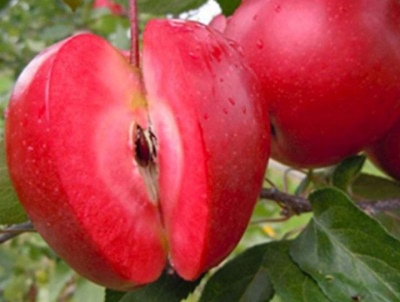
- Authors: breeder Markus Kobelt (Swiss selection)
- Taste: sweet and sour, with a harmonious ratio of acids and sugars
- Fruit weight, g: 160
- The beginning of fruiting varieties: for 3 years
- Ripening terms: early winter
- Removable maturity: at the end of September
- Keeping quality: until the end of March
- Appointment: universal
- Name synonyms: Redlove Era
- Transportability: Yes
The fruits of the Era apple tree can be a tasty and pleasant gift for a diligent gardener. But it is necessary to assess in advance the yield and frost resistance of the plant so that it does not bring unpleasant surprises in return. In addition to the peculiarities of cultivation, it is worth familiarizing yourself with the prehistory of the culture.
Breeding history of the variety
The Era apple tree is a rather rare phenomenon in our area - the result of Swiss selection. The main work on the creation of culture was done by Markus Kobelt. The variety also has an alternative name - Redlove Era. The development is very new and has not yet fully revealed its capabilities. It has already been stated that it has excellent characteristics.
Description of the variety
The plant is distinguished by its expressive versatility. Its fruits are well transported. The era is a fast-growing culture. It is characterized by:
moderately large crown;
reddish foliage;
dark cherry shoots;
dark crimson color of flowers;
a number of advantages when growing.
The growth rate is moderately high. The Era apple tree is characterized by long branches. They are arched and dark gray in color. Shoots are slightly pubescent. Other nuances:
mixed formation of fruits (on biennial shoots and last year's growth);
ovoid foliage;
glossy sheen of the sheet.
Features, pros and cons
No special negative qualities have yet been revealed in this kind of apple tree. But it was found that she:
quickly begins to bear fruit;
the apples obtained are distinguished by a decent taste;
the tree is immune to scab;
resists cold weather well;
looks attractive.
Like other "red-meat" varieties, the Era apple tree comes from the wild-growing apple tree of Nedzwiecki, but far surpassed it. Superiority concerns:
early maturity;
consumer qualities;
collection amount.
Ripening and fruiting
You can expect the first fruits as early as 3 years of cultivation. Even among early-growing apple trees, Era stands out favorably. Apples reach removable ripeness in the last third of September. It is worth noting that now there are already several subspecies of this culture. And in different subtypes, the parameters can differ significantly.
Yield
The volume of apple picking is quite impressive. The exact figures have not yet been given in the sources. This is probably due to insufficient cultivation experience in various localities. You can save the harvest in any household refrigerator.
Fruits and their taste
Era apples have a rounded shape. They are characterized by a sweet and sour taste, the components of which are harmonious. Optimal consumer parameters are reached 20-27 days after harvest. The mass of a single fruit is on average 160 g. You can save the fruit until the beginning of December.
The peel of Era apples is colored in a dark crimson tone. It has a white line in the middle. The content of antioxidants is 30-40% higher than in ordinary apples. When cut, the pulp will not oxidize. The red color of the juice is characteristic, which is not lost even after heat treatment.
You can use Era apples:
fresh;
in fruit salads;
after drying;
in the form of applesauce.

Growing features
All red apple trees should be planted in very moist, nutrient-rich soil. Dark gray and gray forest land is preferred. It is even better to use black soil. Experts recommend choosing areas where the concentration of carbonates (at a depth of no more than 0.8 m) is limited to 10-12%.
Other requirements:
deepening seedlings up to the grafting site;
hole decoration with bumpers 100-150 mm high;
watering 1 time in 10-14 days.



Pollination
The Era variety is self-fertile. Artificial pollination is mandatory. As a pollinator, any apple tree is useful, the ripening dates of which are the same. There is no need for careful selection.



The apple tree is a popular fruit crop among gardeners. It can be found in many summer cottages. But at the same time, such trees are often affected by various diseases. It is very important to recognize the disease in time and carry out the necessary procedures for a speedy recovery. Otherwise, the fruits will be spoiled, and the tree itself may die altogether.












































































